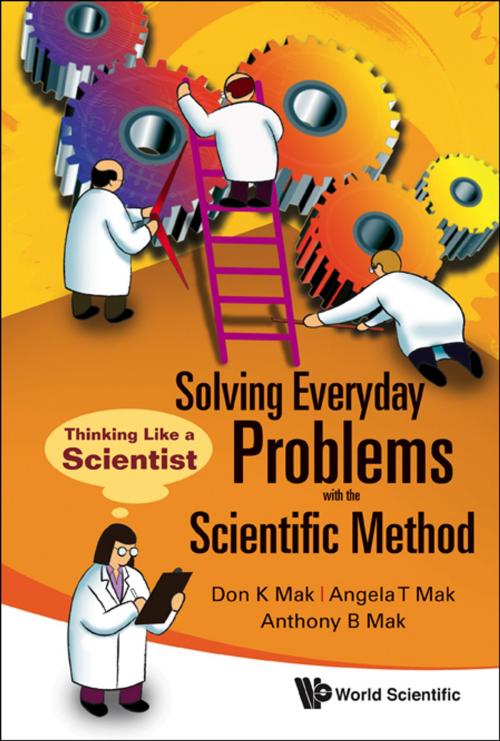Solving Everyday Problems with the Scientific Method
Thinking Like a Scientist
Nonfiction, Science & Nature, Science, Other Sciences, Study & Teaching| Author: | Don K Mak, Angela T Mak, Anthony B Mak | ISBN: | 9789814338448 |
| Publisher: | World Scientific Publishing Company | Publication: | January 5, 2009 |
| Imprint: | WSPC | Language: | English |
| Author: | Don K Mak, Angela T Mak, Anthony B Mak |
| ISBN: | 9789814338448 |
| Publisher: | World Scientific Publishing Company |
| Publication: | January 5, 2009 |
| Imprint: | WSPC |
| Language: | English |
This book describes how one can use The Scientific Method to solve everyday problems including medical ailments, health issues, money management, traveling, shopping, cooking, household chores, etc. It illustrates how to exploit the information collected from our five senses, how to solve problems when no information is available for the present problem situation, how to increase our chances of success by redefining a problem, and how to extrapolate our capabilities by seeing a relationship among heretofore unrelated concepts.
One should formulate a hypothesis as early as possible in order to have a sense of direction regarding which path to follow. Occasionally, by making wild conjectures, creative solutions can transpire. However, hypotheses need to be well-tested. Through this way, The Scientific Method can help readers solve problems in both familiar and unfamiliar situations. Containing real-life examples of how various problems are solved — for instance, how some observant patients cure their own illnesses when medical experts have failed — this book will train readers to observe what others may have missed and conceive what others may not have contemplated. With practice, they will be able to solve more problems than they could previously imagine.
Contents:
- The Scientific Method
- Observation
- Hypothesis
- Experiment
- Recognition
- Problem Situation and Problem Definition
- Induction and Deduction
- Alternative Solutions
- Relation
- Mathematics
- Probable Value
Readership: General public interested in self-help books; undergraduates majoring in education and behavioral psychology; graduates and researchers with research interests in problem solving, creativity and scientific research methodology.
Key Features:
- Demonstrates how to cope with problems in both familiar and unfamiliar situations, using The Scientific Method
- Redefines problems by viewing the problem situation from different levels and perspectives
- Formulates solution methodology by borrowing ideas from economics, philosophy, logic, statistics, probability theory and scientific research
- Offers test-driven recommendations, supported with real-life examples
This book describes how one can use The Scientific Method to solve everyday problems including medical ailments, health issues, money management, traveling, shopping, cooking, household chores, etc. It illustrates how to exploit the information collected from our five senses, how to solve problems when no information is available for the present problem situation, how to increase our chances of success by redefining a problem, and how to extrapolate our capabilities by seeing a relationship among heretofore unrelated concepts.
One should formulate a hypothesis as early as possible in order to have a sense of direction regarding which path to follow. Occasionally, by making wild conjectures, creative solutions can transpire. However, hypotheses need to be well-tested. Through this way, The Scientific Method can help readers solve problems in both familiar and unfamiliar situations. Containing real-life examples of how various problems are solved — for instance, how some observant patients cure their own illnesses when medical experts have failed — this book will train readers to observe what others may have missed and conceive what others may not have contemplated. With practice, they will be able to solve more problems than they could previously imagine.
Contents:
- The Scientific Method
- Observation
- Hypothesis
- Experiment
- Recognition
- Problem Situation and Problem Definition
- Induction and Deduction
- Alternative Solutions
- Relation
- Mathematics
- Probable Value
Readership: General public interested in self-help books; undergraduates majoring in education and behavioral psychology; graduates and researchers with research interests in problem solving, creativity and scientific research methodology.
Key Features:
- Demonstrates how to cope with problems in both familiar and unfamiliar situations, using The Scientific Method
- Redefines problems by viewing the problem situation from different levels and perspectives
- Formulates solution methodology by borrowing ideas from economics, philosophy, logic, statistics, probability theory and scientific research
- Offers test-driven recommendations, supported with real-life examples















